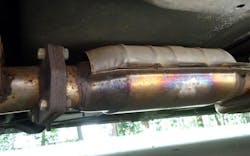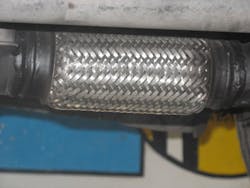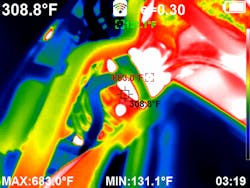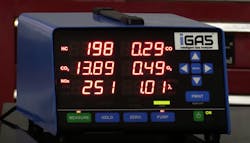The “Catalytic Converter Efficiency” Diagnostic Trouble Codes (DTCs) P0420 and P0430, are among the top 10 DTCs technicians face. And while the description might imply a failed converter, odds are the ultimate fault lies somewhere else.
The catalytic converter is the last stop for the exhaust gasses generated by the engine during operation. It is here that the last remaining pollutants are cleaned up before finally exiting the tailpipe.
There are three ways a converter can fail:
- Overheated, melted, or broken substrate in the converter
This is usually caused by any factor that affects the engine’s air/fuel mixture and the resulting feed gasses being sent to the converter. Even slight variations will cause the converter temperature to rise significantly.
- Converter poisoning
Converter poisoning means that the substrate has been coated by a foreign substance and is no longer exposed to the exhaust stream. Excessive oil consumption and coolant leaks past the intake or head gaskets are common contaminates, as is the improper use of certain sealants.
- Structural damage
Structural damage can be physical damage like dents caused by road debris striking the housing, stripped oxygen sensor threads, thermal shock to the converter, and metal fatigue at mounting points or welds.
How to tackle these DTCs
When tackling these DTCs, you must first determine if the converter has truly failed or not. You'll be surprised at how many P0420/P0430 codes are corrected without replacing the cat!
If the converter has failed, you also need to identify what caused the converter to fail. Sure, age is a factor - but there are other factors that can result in premature failure and if left uncorrected, the new replacement won't last long.
And if it the converter hasn't failed, you need to determine what caused the ECM to set the code(s) anyway! False catalytic converter codes are not uncommon and in many instances, a reflash is all that is required to correct the concern.
Start by taking the vehicle for a test drive. Is there any indication of sluggish response or low power that might indicate an exhaust restriction resulting from a melted or broken substrate? Do you hear any rattling noises coming from the area of the converter?Next, a scan tool check. First to verify the presence of the P0420 and/or P0430 DTCs but to also check for any others that might be recorded in the ECM. Any DTC or condition that increases emissions or affects sensor readings can cause a converter to fail the ECM tests even if the converter is good. Correct all other DTCs first and allow the Catalytic Converter monitor to run again before proceeding.
While the scan tool is connected, review the fuel trim data PIDs. Do they indicate a system lean or rich condition? If the vehicle is equipped with dual exhaust and dual converters, is one bank skewed lean while the other is skewed rich?
If the vehicle uses a conventional oxygen sensor upstream of the converter, graph and compare the signals from the upstream and downstream sensors. Most ECMs rely on this data to assess the condition of the converter. The front sensor should switch normally while the rear sensor should remain relatively steady. If it, too, fluctuates the same as the front sensor, it is an indication that the converter has failed OR the converter has not started working, also known as “lighting off”, because of an emissions problem with the engine.
Vehicles using Wide Band Air Fuel Sensors use a different diagnostic strategy so take advantage of the data Mode $06 has to offer to help in your diagnosis.
Next, put the vehicle up in the air and inspect the exhaust system and converters for damage or obvious leaks. Common sources of air leaks into the exhaust that can skew the ECM’s tests are damaged flex pipes and stripped or damaged sensor threads.
A smoke machine, especially one that can adjust the amount of pressure delivered, is one way to find elusive leaks. The use of an ultrasound tool like this is another way to locate leaks that you can’t visually see. Another simple way to check the exhaust is to connect your shop vacuum cleaner to the exhaust, moving the hose to the outlet side and turning it on. Seal the hose to the exhaust and use a soapy water solution to check for leaks.
After a quick visual, you can use a thermal imaging camera to “see” the converter in action.
Start the engine and allow it to reach operating temperature and check the temperature of the converter's front weld ring.When using a five-gas analyzer, keep in mind that:
- High HC emissions indicate unburned fuel.
- High CO levels indicate partially burnt fuel or oil.
- High NOx levels are normally caused by high combustion temperatures and pressures, slightly lean air/fuel mixture, and excessively advanced ignition timing.
Tailpipe emissions readings low in HC and CO levels with high NOx emissions are typically not caused by a defective converter. The low HC and CO readings indicate that the converter is functioning. The root cause of the problem is an engine that is emitting excessively high NOx emissions, which in turn are caused by excessive combustion chamber temperatures.
Any cylinder that is not working as hard as the others is the most likely cause of emissions issues. Most professional scan tools can accurately perform a cylinder balance test by dropping one cylinder at a time.
You can also use the thermal imager to check cylinder power balance. Look for cylinders that are running hotter or colder than the others. Once identified, you can focus your attention on the odd man out.
Remember, diagnosing Catalytic Converter Efficiency Below Threshold DTCs requires you to do two things. First, to determine the actual condition of your customer’s converter, and two, determine what caused it to go bad in the first place OR if the converter is good, to determine what caused the ECM test to fail.
If you don’t take the time to correct the true cause, you’ll only set yourself up for a dissatisfied customer and an expensive comeback.
Learn more about the most common DTCs here.






